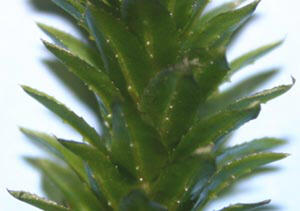Hydrilla
Hydrilla Hydrilla verticillata
Is hydrilla found in Kansas?
- Hydrilla is found in Olathe-Blackbob Park Pond.
- The Kansas Dept. of Agriculture, Dept. of Wildlife and Parks, and the City of Olathe are attempting to eradicate this population beginning in 2009.
Where did hydrilla come from?
- Hydrilla is a native to Asia.
- Hydrilla has spread to Europe, Australia, New Zealand, the Pacific Isalnds, Africa, South American, & North America.
What does hydrilla look like?
- Hydrilla is a submersed plant with long, slender stems that branch and spread across the water surface.
- Leaves are small, pointed and arranged in whorls of 4 to 8 along the stem.
- Leaf margins are distinctly saw-toothed; the plant is noticeably rough to the touch when pulled through the hand.
Why is hydrilla a problem?
- Hydrilla seriously interferes with boating, both recreational and commercial, and prevents swimming and fishing; major infestations limit sportfish weight and size.
- Hydrilla greatly slows water flow and clogs irrigation and flood-control canals.
- When hydrilla invades, ecologically-important native submersed plants are shaded out by hydrilla's thick mats, or are simply out-competed, and eliminated.
How do we control hydrilla?
- Hydrilla spreads to new waters mainly as fragments on boats and trailers, so to prevent its spread, be vigilant about cleaning your equipment.
- In a waterbody, Hydrilla can be controlled by biological, mechanical, and chemical means, but prevention is the best method of control.
- Contact your local Kansas Department of Agriculture office for specific control techniques for an established population.
- Early detection of isolated populations may help prevent their spread. Your help to report new sightings and to prevent their spread is vital.
What do I do if I find hydrilla?
- If you discover hydrilla, note the date and location, and contact your local Kansas Department of Agriculture office, the Emporia Research Office at (620) 342-0658, or email the Aquatic Nuisance Species Coordinator.
Images and Recent news
Hydrilla links:








